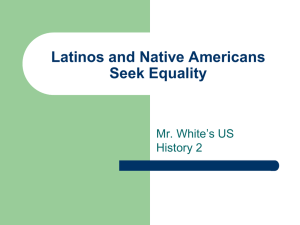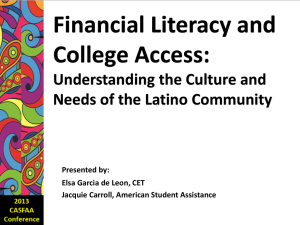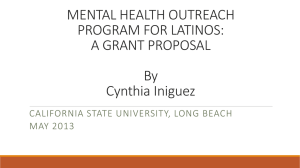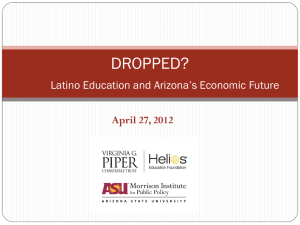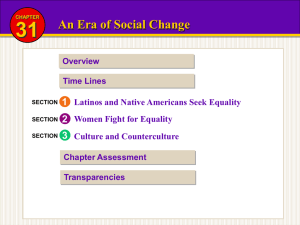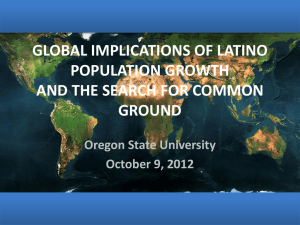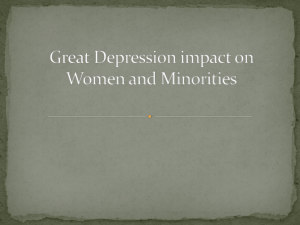Latinos in the United States in 2010 and the Future of the Country
advertisement
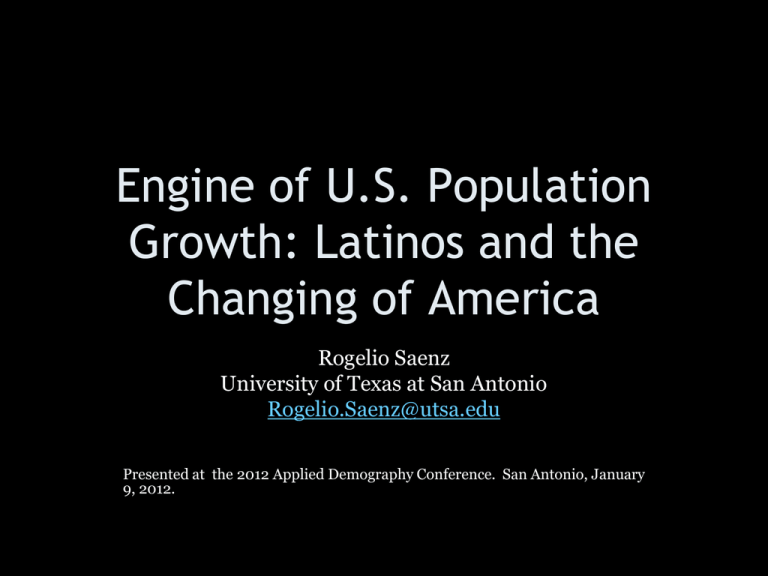
Engine of U.S. Population Growth: Latinos and the Changing of America Rogelio Saenz University of Texas at San Antonio Rogelio.Saenz@utsa.edu Presented at the 2012 Applied Demography Conference. San Antonio, January 9, 2012. Major Messages • The U.S. population and that of most states is undergoing major demographic transformations. • Latinos represent the engine of U.S. population change. • The increasing presence of Latinos in the future population of the U.S. will impact all institutions, including education and the military. • Challenge to the traditional black-white framework that has dominated U.S. • Latino growth in U.S. and demographic implications for Mexico and Latin America • New era? Latinos: Newcomers in the United States? • Common view of Latinos as immigrants who have come only recently to this country • Initial emergence of Latino incorporation into the United States • • • • • Mexicans in 1848 Puerto Ricans in 1920s Cubans and Dominicans in late 1950s-1960s Central Americans in 1970s-1980s South Americans in 1980s-1990s Who are Latinos or Hispanics? “’Hispanic or Latino’ refers to a person of Cuban, Mexican, Puerto Rican, South or Central American, or other Spanish culture or origin regardless of race.” Source: U.S. Census Bureau. Groups Constituting Latino Population in 2010 Mexican Puerto Rican Cuban Salvadoran Dominican 31,798,258 4,623,716 1,785,547 1,648,968 1,414,703 Peruvian Nicaraguan Argentinean Venezuelan Panamanian 531,358 348,202 224,952 215,023 165,456 Guatemalan Colombian Spaniard Honduran Ecuadorian 1,044,209 908,734 635,253 633,401 564,631 Chilean Costa Rican Bolivian Uruguayan Paraguayan 126,810 126,418 99,210 56,884 20,023 Note: There are 3,452,403 persons classified as “All Other Hispanic or Latino,” 31,626 as “Other Central American,” and 21,809 as “Other South American.” Latinos as the Engine of U.S. Population Change Latino Population, 1980 to 2010 Percentage Change in the Latino and the U.S. Population by Period Percentage of U.S. Population Growth Due to Latino Population Growth by Period Total Population and Latino Growth by Region, 2000-2010 Region Total % Chg. Latino % Chg. Northeast Midwest South West 3.2% 3.9% 14.3% 13.8% 33.1% 49.2% 57.3% 34.3% 100.9% 60.7% 46.4% 60.1% 9.7% 43.0% 55.5% U.S. % Region Chg. Due to Latinos Note: In the Northeast, the non-Latino population declined. The overall regional population increased by 1,722,862 with the Latino population increase being 1,737,862. Percentage of U.S. Population that is Latino, 1980 to 2010 Percent of Region Populations that are Latino, 2010 Northeast Midwest South West 12.6% 7.0% 15.9% 28.6% U.S. 16.3% Highlights of Latino Population: The 1980-2010 Period • Expanded 3.5 times between 1980 and 2010 • More than 2 of 5 (44%) of persons added to the U.S. population between 1980 and 2010 have been Latino • Designated the largest minority group in the United States in 2003 Why the Rapid Growth among Latinos? • Demographic factors – Age Structure – Immigration – Natural Increase (Fertility – Mortality) Age Structure: Youthful Latino population with a median age of 27 (versus 41 for whites) in 2009 Age-Sex Pyramids for Latinos and Whites in the United States, 2009 Immigration: Approximately half of persons immigrating (legally) to the United States since 1990 have come from Latin America (versus 15% from Europe) Fertility: High Latina fertility with a Total Fertility Rate of 3.0 (versus 1.9 for whites) in 2007 Mortality: Latino males outlived white males by 2.3 years while Latina females outlived white females by 2.7 years in 2006 Natural Increase in 2000-2009: A Tale of Whites and Latinos • Whites • About 21 million births and 18 million deaths • Latinos • Approximately 9 million births and over 1 million deaths • Result • Whites: 1.1 births for every 1 death • Latinos: 8.9 births for every 1 death • Major implications for the widening of the growth rates between Latinos and whites in the near future Decomposition of Latino Population Growth in 2000-2009 Period • 63% due to natural increase (births – deaths) • 37% due to net immigration (persons entering U.S. – persons leaving U.S.) Ongoing Latino Demographic Trends A Demographic Harbinger In 2009 for the first time, Latino children represented the majority of first-graders enrolled in the state of Texas. Percentage Share of Latinos and Whites in the Texas Population by Age, 2008 80 70 60 Pct. 50 Latino 40 White 30 20 10 0 0-4 5-9 10-14 15-19 20-24 25-29 30-34 35-39 40-44 45-49 50-54 Source: 2008 1% ACS. 55-59 60-64 65-69 70-74 75-79 80-84 85+ Percentage Share of Latinos and Whites in the California Population by Age, 2008 80 70 60 Pct. 50 Latino 40 White 30 20 10 0 0-4 5-9 10-14 15-19 20-24 25-29 30-34 35-39 40-44 45-49 50-54 Source: 2008 1% ACS. 55-59 60-64 65-69 70-74 75-79 80-84 85+ Percentage Share of Latinos and Whites in the Arizona Population by Age, 2008 100 90 80 70 Pct. 60 Latino 50 White 40 30 20 10 0 0-4 5-9 10-14 15-19 20-24 25-29 30-34 35-39 40-44 45-49 50-54 Source: 2008 1% ACS. 55-59 60-64 65-69 70-74 75-79 80-84 85+ Where Are Latinos Concentrated? 12 States with Largest Latino Populations, 2010 [41 million Latinos or 81% of all Latinos in U.S.] States Where Latinos Account for 20% or More of Population, 2010 New Mexico California Texas Arizona Nevada Florida Colorado 46.3% 37.6% 37.6% 29.6% 26.5% 22.5% 20.7% 12 States with Largest Growth in Latino Population, 2000-2010 California Texas Florida Arizona New York Illinois New Jersey North Carolina Georgia Pennsylvania Nevada Washington 3,047,163 2,791,255 1,541,091 599,532 549,339 497,316 437,953 421,157 418,462 325,572 322,531 314,281 12 States with Highest Percentages of Latino Growth, 2000-2010 [Pct. Growth: 92% to 148%] A Social and Economic Overview of Latinos: Rogelio Saenz Report titled Latinos in the United States 2010 Available at: http://www.prb.org/pdf10/latinos-update2010.pdf Language Patterns • Foreign-born Latinos more likely to speak only Spanish than U.S.-born Latinos • Foreign-born Mexicans (52%), Central Americans (48%), Dominicans (45%), and Cubans (43%) • U.S.-born Latinos are more likely to be monolingual English speakers compared to foreign-born Latinos • For almost all subgroups, regardless of nativity status, the largest segment of the population are bilingual speakers Socioeconomic Patterns • Foreign-born Latinos lag behind their respective native-born counterparts in high school graduation rates, occupational socioeconomic index, median family income, and possession of health insurance • Generally foreign-born individuals have lower unemployment rates than U.S.-born persons Stratification Within Latino Populations • Top • South Americans, Cubans, Other Latinos • Middle • Central Americans • Bottom • Puerto Ricans, Mexicans, Dominicans • NOTE • Foreign-born South Americans, Cubans, and Other Latinos do better than U.S.-born Mexicans, Puerto Ricans, and Dominicans Latinos Compared to Whites • Large majority of Latinos--especially Mexicans, Puerto Ricans, and Dominicans--lag significantly behind whites socioeconomically • U.S.-born South Americans and Cubans do better than whites with respect to levels of high school completion and median family income Epidemiological Paradox AKA Mexican Immigrant Paradox • Despite low socioeconomic status of Latino population and low health insurance coverage, Latinos, especially Mexicans, have low mortality rates and high life expectancy even compared to whites • Explanations • Migrant selectivity from home country • Protective immigrant culture and lifestyle • Methodological and data limitations Impact of Economic Crisis • Latinos and whites experienced about 4% increase in unemployment rates between 2000 and 2009 • U.S.-born Latinos greater increases in unemployment compared to foreign-born Latinos • After adjusting for inflation, median family income of Latinos (-7.1%) decreased faster than that for whites (-5.9%) between 1999 and 2008 • Median incomes of foreign-born Latinos declined faster than those of U.S.-born Latinos Major Demographic Implications in the Other America: Mexico and Beyond Aging of the Population • Major drop in TFR in Mexico – 1960: 7.3 – 1970: 6.8 – 1980: 4.7 – 1990: 3.3 – 2000: 2.4 – 2010: 2.3 • TFR in Latin American and Caribbean in 2010: 2.2 Selective Outmigration from Latin America • Drawn from younger segments of the population – Teens to 30’s Declining Births and Net Outmigration of Young Adults = Aging of Population Percentage of Mexico’s Population 60 and Older: 1950 to 2050 30 24.7 25 Pct. 60+ 20 14.2 15 10 7.1 5.5 5.6 5.6 1950 1960 1970 6.1 5 0 1990 2000 Fuente: INEGI; U.S. Census Bureau World Projections 2020 2050 New Origins: Counterpart to New Destinations • Attention in U.S. to new destinations, places (many of these rural) located in regions of U.S. where Latinos have historically been absent • NAFTA has uprooted small-scale corn producers who cannot compete with U.S. corn growers, many of these located in indigenous areas of Mexico that have historically had low migration – New Origin states include Chiapas, Oaxaca, and Yucatan New Era of Latino Demography in U.S.? • Immigration has been an important feature of Mexican-origin and Latino population growth in U.S. throughout 20th century (exception being Depression era) • Constant flow of Mexican and Latin American newcomers • New pattern: flow of Mexican and Latin American immigration to U.S. has been reduced dramatically • Temporary or long-term? Possible Implications if Immigration Reversal Long-Term • Share of U.S. citizens among Latino population will rise? – Political implications • Probability of greater integration of Latinos? – White ethnic groups have experienced upward mobility when immigration of their national-origin groups halted – Issue of color • Alteration in cultural and language retention among Latinos? • Maintenance or erosion of transnational ties to countries of origin? Implications for Status of Latinos as the Engine of U.S. Population Change? • Likely to continue – Latinos continue to be very young – No signs that other racial/ethnic groups will experience significant increases in fertility Despite overall low socioeconomic standing of Latinos… • Buying power of Latinos more than doubled over past decade (108% versus 52% for U.S.) • The $1 trillion buying power of Latinos in 2010 is larger than economies of all but 14 countries • Latino buying power expected to increase from $1 trillion in 2010 to $1.5 trillion in 2015 (11% of U.S. total buying power) Source: Selig Center for Economic Growth (University of Georgia) http://www.terry.uga.edu/news/releases/2010/minority-buying-power-report.html Concluding Thoughts Despite these trends.... • Latinos continue to be seen as perpetual foreigners despite having long historical roots in the U.S. • Latinos continue to be ignored in much of social and political life in the U.S. – Mass media – Political dialogue The Reality • U.S. institutions will increasingly be affected by and dependent on Latinos in the coming decades. – Military institution –Business community –Higher education system –Political institution –Health care system –Religious institution –Housing institution Implications for Higher Education • Future higher education cohorts will increasingly come from Latino population • Major challenge: leakage in the Latino educational pipeline Dropout rates among youth of 50% or higher not uncommon [national tragedy; loss of such much human potential] • Higher education institutions need to play a leading role in creation of K-16 programs for Latinos • Need improvements in recruitment, retention, and graduation of Latino college students Latinos: A National Asset • Latinos ignored in many social and political domains in the United States • Need to view Latino population as an asset not a liability • Invest in education of Latino youth • Case of Dalton, Georgia El Fin
